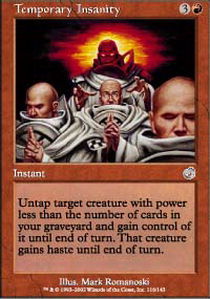Winning when your limited luck is down! Part 2

This is the second instalment of my two part article about how to keep your cool when it’s looking bad in limited. The first part described ways to build your deck when you get a genuinely terrible pool. This part is more general limited information, but is also highly important when you are down and out of luck and contains some sealed specific thoughts on avoiding tilt.
The main principles
- Every deck has a weakness even if that weakness is just that it suffers from mana floods and screws.
- The fewer weaknesses a deck has the stronger your focus on these weaknesses should be.
- Your deck has weakness too and spotting how your opponents attack these is also important.
Sideboarding
People often think that limited has very few sideboard cards, our minds conjure up images of Clip wings in Shadows Over Innistrad or Pyroblast in Eternal Masters but people often never think of filler cards as potential sideboard gems. I’m talking about those extra 4 mana 2/4’s and 1/5 flyers. The cards that are playable but don’t make your deck because they aren’t stellar, they don’t fit the curve or you already have too many copies of said card in your deck.
A huge part of taking advantage of strengths and shoring up weaknesses in limited can come from these cards if you are down and out of luck. The best way I can explain this in sideboarding terms would be to imagine your average limited deck is facing off against a slow ground deck with many high toughness creatures that you just can’t attack through in combat. In this scenario sideboarding out some lower drops (that won’t do enough in the early game to compensate for how bad they are in the mid to long game). Whilst putting in more inefficient or slow cards that can win you slow games that a 3 mana 3/2 cant. Examples might include flyers too inefficient to make a normal deck, big late game creatures or some grindy quirky cards that are slow but guarantee the win eventually. Clearly this example is just the tip of the iceberg.
Below are the questions I ask myself at the end of game one and then re-evaluate after game two:
- Was their deck fast or slow?
- How many creatures were there? Many/few?
- What were the mana costs and tempo effects of those creatures?
- What were the stats of those creatures like?
- How much removal did they play?
- What was that removal like? Instant/Sorcery/Conditional/mana costs/etc.
- Were there problematic permanents? Planeswalkers/Enchantments/Artifacts/etc.
- Did the deck have a theme? Delirium/ Madness/ Flyers/ etc.

These questions help to evaluate strengths and weaknesses of opponent’s decks and can obviously help in more ways than the example I gave above. I will have to keep it brief and to the point but I will try to give a fair rundown of all the sections. The general rule is that once you have noticed what your opponent’s deck is good and bad at it is then easy to attack and defend those points in sideboarding and mulligans.
The speed of the deck goes along with the mana cost and tempo effects of the creatures as well as their stats. Now obviously your actions are different depending on your strategy but the general rule is to notice the stats of creatures and their speed and sideboard accordingly. Now I realise I am being very vague here but the thing I am trying to point out is that many people would never consider siding out some cards for example a Shock or 2 mana 2/2. Shock is one red mana and deals 2 damage at instant speed to any target….why would you side that out?? Well say if you have several cards like that and you noticed after two games that the opponent seemingly only has 3 toughness and up creatures and the shocks were sitting dead in your hand a lot; it effectively becomes +2/+0 combat trick with a small upside. In a case like this your opponents deck is strong against 2 damage spells and 2 power creatures, situational removal or bounce may be better or straight combat tricks or a face crushing eldrazi!

This idea goes deeper, lets take auras as an example. Auras are generally bad and regarded as unplayable despite their often powerful effects. This is due to the 2 for 1 factor when the buffed up creature hits the graveyard. Well what if you’ve noticed over two games that the opponent has almost no removal and/or that removal is conditional, it might be time for that +2/+2 and flying enchantment out of the sideboard as this takes advantage of the opponents relative inability to spot remove creatures. This can be especially relevant when your deck is very sub par as mentioned in article part 1 as auras can end games quickly if left unanswered.
Tilt

Tilt also known as throwing away games because you are in a bad mood, is one of the worst things to have/ do when your sealed pool is subpar. I know it’s easier said than done but when you are down on your luck the best thing to do is forget all of the negatives; the rares other people opened, how you don’t have any removal etc. You can still win games and all you need to do is make it to that top 8 draft, day 2 or next stage of the event.
We all know that tilt is bad and sealed pools seem to be one of the things that tilts players the most. So how do we minimise this? I try to remember these points:
- You can still make the next stage of the event and get a shot with a new deck.
- You have a strategy to follow.
- Sealed has the most variance of tournament magic and the decks are rarely streamlined.
- Many people build to the rares, this can lead to bad decks.
- If you lose to a deck full A+ bombs and a solid curve and there was nothing you can do then that’s just life and try to play the best magic you can.
- The chances of you playing an A+ deck more than once is low ,more than twice extremely low. There shouldn’t be too many rounds where the odds are super stacked against you.
- The more you win the harder it gets as good players and decks move up the standings, luckily these end rounds are the ones that you can intentionally draw meaning less overall rounds played with the sub optimal deck.
I hope you find these tips useful in your next limited tournament. If you have any question or any special method you use in these circumstance please post in the comment section below.





